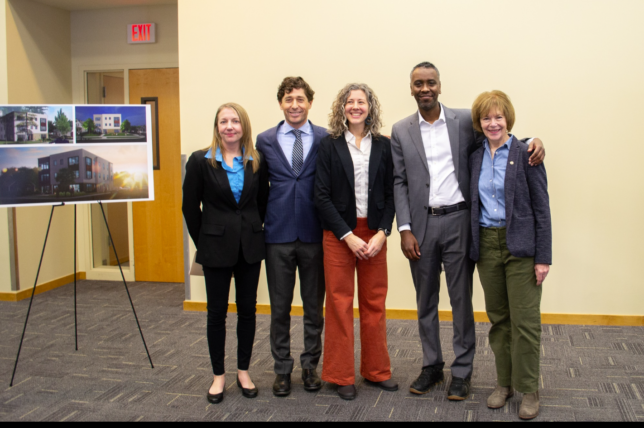
On January 12th, 2023, a familiar cast of characters gathered to celebrate the groundbreaking of Minneapolis Public Housing Authority’s Family Housing Expansion Project (FHEP). Mayor Jacob Frey and Senator Tina Smith joined MPHA Executive Director Abdi Warsame to extoll the benefits of safe and “affordable housing” as they detailed plans to replace 16 public housing scattered sites single-family homes with modular fourplexes. The laudatory and celebratory tone of the press conference is not new. Most of the press coverage since the announcement of the FHEP has generally celebrated the project as “more public housing coming to Minneapolis.” Unfortunately, this is categorically untrue. The FHEP definitely involves converting public housing to housing leased through the private market. Over the last year of careful on-the-ground research and document analysis, Defend Glendale, and Public Housing Coalition (DG&PHC) has uncovered key details about the FHEP, its funding sources, and likely implications on the future of public housing in the city.
It is first necessary to provide a brief history of Minneapolis’ management of “scattered site” public housing. For decades, MPHA operated over 736 single-family public housing homes rented to large low-income families, each paying 30% of their income for rent and utilities. The scattered site public housing units are in high demand, and it takes 5 to 7 years to get off the scattered site waitlist because the homes are in high demand. MPHA states that 7500 people are on a wait list. The City needs to build more public housing especially single family public housing homes that allows large families to live affordably and with dignity. Currently, the families that live in Minneapolis scattered-site public housing homes are all poor/low-income and predominantly Black, Black immigrant, and Brown.
Despite the scattered sites’ importance and popularity, since 2018, MPHA and the City of Minneapolis have claimed that homes must be privatized through Section 18 Demolition & Disposition Conversion. This type of conversion is a process approved by the City of Minneapolis and HUD that allows Public Housing Authorities (PHA) to transfer ownership of single-family public housing units to private sector entities. With the permission of the City of Minneapolis, MPHA, Mayor Jacob Frey and former Council Member Lisa Bender lobbied HUD to allow MPHA to use Section 18 Demolition & Disposition to privatize and extract the homes from the public housing stock and transfer the ownership of the homes to its own private “nonprofit”, Community Housing Resources (CHR). As a nonprofit without any legal obligation to the general public, MPHA’s claims that CHR is an accountable public entity “wholly owned and operated” by MPHA are ludicrous. After Section 18 Conversion, rent is subsidized through Section 8 vouchers rather than fixed at 30% of residents’ income under Section 9 (Public Housing). Because of this, MPHA claims displacement should be minimized.
The Minneapolis City Council’s unanimous passage of the Minneapolis 2040 plan in 2019 further expedited MPHA’s plans to privatize the scattered sites. Minneapolis 2040 involves the elimination of single-family zoning across most of the city by the year 2040. Unfortunately for scattered site residents, this means that the public lots their houses are built on will be soon upzoned, and sold meaning that the homes will be torn down and replaced with apartment buildings that are more expensive and smaller units, usually four-plexes. Although full implementation of the 2040 plan has been in and out of the Hennepin County Courts, the damage to public housing residents is still done.
The Family Housing Expansion Project is simply the name Senator Tina Smith, the City of Minneapolis and MPHA have given to the latest wave of ending public housing like scattered site privatizations through Section 18. What differentiates these conversions from previous conversions is the combination of 16 conversions at one time and the replacement of all 16 homes with new, cheaply constructed “modular” apartment buildings with small-size units.In July 2021, FHEP was granted $4.6 million by the City of Minneapolis and the demolition process began in the Fall of 2021, when MPHA told residents they would soon have to leave, offering no formal guarantee of relocation. Most recently, the FHEP was granted another $1.4 million by the Metropolitan Council, followed by the Minneapolis City Council BHIZ Committee issued a bonding bill. By summer of 2022, all 16 homes had been vacated. Virtually all governmental entities in the Metro area had rubber stamped the project, upholding MPHA’s narrative that the project would cause “no displacement” and that “residents would be able to move back in” once the new buildings were completed. This is false.
As usual, MPHA’s narrative does not hold up to scrutiny. Over the last year, we visited the 16 scattered site addresses slated for conversion a few times. By the summer, homes that were previously occupied showed signs of abandonment. For example, in the backyard of one scattered site home, we found most of the previous residents’ furniture and kid’s tows thrown in a pile. This suggests that relocation was not as smooth and painless as MPHA promised. Displacement is a traumatic experience, especially considering that some families reported having just moved into their scattered site only a few months before the initiation of the FHEP.
Before demolition, residents we talked to expressed concern that the new apartment units would be too small to fit their families. The appeal of scattered site housing is space for large families, and many scattered sites have a yard, porch space, and a storage shed, along with the multiple bedrooms and bathrooms necessary to house large multi-generational families.. This space will be eliminated as the replacement units will be smaller than the homes previously occupying their lots, according to the Met Council. In the place of these homes, MPHA and a private contractor are erecting buildings that are composed of four prefab pods placed together like a Lego set. Residents’ fears are entirely justified, especially considering that MPHA and its affiliated nonprofits typically use apartment square footage to cap the number of people able to live in a unit. The City of Minneapolis and MPHA wants the public to believe their lies despite obvious holes in their narrative. How can families come back to small units that they can’t legally live in due to occupancy caps?
Finally, the Section 18 conversion process inherently privatizes public housing, meaning that many of the guarantees and legal protection made to public housing residents dissipate. Once public housing has been privatized, there will be no long-term affordability to guarantee the new apartments will be 30% of the tenant’s income for rent, including utilities. Ownership structures become confusing and opaque and it becomes harder to hold landlords accountable.Instead of dealing with MPHA directly, residents’ landlord will (at first) be yet another bizarre nonprofit entity – this time called Family Housing Resources (FHR). Of course, MPHA claims that because FHR – just like CHR – is” wholly operated” by MPHA itself, residents will experience no change.
The Section 18 conversions of scattered sites before the FHEP show the real story. Because CHR has no accountability to the general public, it is allowed to profit from the displacement of poor, and disabled families. The new leases residents were forced to sign after Section 18 conversion no longer guaranteed the 30% of income for rent and utilities that are guaranteed under public housing. Instead, MPHA and the City state that rents and fees will be adjusted in the future, under the auspices of “rent reasonableness”. Nothing is stopping CHR from increasing rents and making the units unaffordable to the median household in Minneapolis public housing, whose income was $10,758 in 2021. Other residents whose homes were converted before 2022 say that they were hit with confusing fees in their rent and increasingly neglected maintenance requests, causing most units to be unlivable. Some residents faced eviction because they could not pay rent. In some cases, these conditions escalated to the point where residents moved out of their units and used the Section 8 vouchers to find other housing, pushing them out of their community and city.
The story of the Elliot Twins – two former public housing buildings in Ward 6 – also illustrates what we can expect from FHR’s management of the 16 new modular buildings. The Elliot Twins were privatized through HUD’s Rental Assistance Demonstration program – the analogue to Section 18 for highrise buildings. Similar to scattered site residents whose homes MPHA previously converted through Section 18, MPHA lied to, harassed, and intimidated Elliot Twins tenants, many of whom were eventually displaced and forced to take Section 8 Vouchers. No one knows what happened to these tenants.
After the Twins’ conversion, MPHA used its typical tactic of creating shell organizations (like FHR and CHR) to manage the property and oversee leasing. However, the land underneath the two buildings was sold to the Royal Bank of Canada, with additional construction capital from Bremer Bank. These investors are now profiting from Elliot Twins by exploiting federal low-income housing tax credits and large amounts of affordable housing funds from the state, county, city and HUD. Its possible that FHR could simply sell off the new modular units to a private financial institution once the FHEP finishes up next December. We expect similar results as FHR takes over the new modular buildings and the FHEP finishes up next December.
Ultimately, the FHEP is just one part of MPHA’s plan to eventually destroy all 736 scattered site homes so that the public land they formerly sat on can be leased to developers for profit. The plan to end public housing and displace low-income Black and Brown families was hatched by so-called “progressive” politicians whose end goal is to enrich their friends in finance and real estate, including so-called “nonprofit” developers. As the city dismantles public housing in the midst of a housing crisis, Black and Brown neighborhoods gentrify. And, the resulting skyrocketing rents and tax credits enrich developers. All the while, nobody from the city has been able to answer the most important questions:
- What happens to the families displaced and forced to move out?
- Will these families be on a waitlist at local shelters?
- Where will they sleep?
- What will happen to the schooling of their children and stability?
- Will these families add to the number of families seen daily living in their cars or encampments that Mayor Frey and his police force constantly destroy?
- What will happen to the families when the Section 8 vouchers MPHA and the City forces on them expire between 60 to 120 days?
Defend Glendale & Public Housing Coalition
defendglendale @ gmail. com | www.dgphc.org | facebook @ defendglendale
| twitter @ defendglendale
| Instagram @ defendglendale
612-389-8527
P.O. Box 14616, Minneapolis, MN 55414
